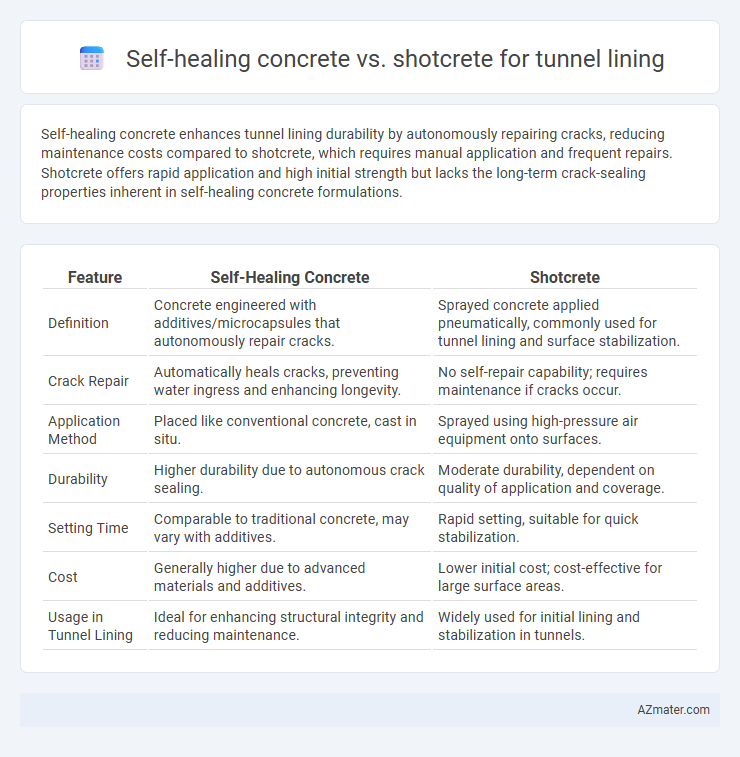Self-healing concrete enhances tunnel lining durability by autonomously repairing cracks, reducing maintenance costs compared to shotcrete, which requires manual application and frequent repairs. Shotcrete offers rapid application and high initial strength but lacks the long-term crack-sealing properties inherent in self-healing concrete formulations.
Table of Comparison
| Feature | Self-Healing Concrete | Shotcrete |
|---|---|---|
| Definition | Concrete engineered with additives/microcapsules that autonomously repair cracks. | Sprayed concrete applied pneumatically, commonly used for tunnel lining and surface stabilization. |
| Crack Repair | Automatically heals cracks, preventing water ingress and enhancing longevity. | No self-repair capability; requires maintenance if cracks occur. |
| Application Method | Placed like conventional concrete, cast in situ. | Sprayed using high-pressure air equipment onto surfaces. |
| Durability | Higher durability due to autonomous crack sealing. | Moderate durability, dependent on quality of application and coverage. |
| Setting Time | Comparable to traditional concrete, may vary with additives. | Rapid setting, suitable for quick stabilization. |
| Cost | Generally higher due to advanced materials and additives. | Lower initial cost; cost-effective for large surface areas. |
| Usage in Tunnel Lining | Ideal for enhancing structural integrity and reducing maintenance. | Widely used for initial lining and stabilization in tunnels. |
Introduction to Tunnel Lining Technologies
Self-healing concrete incorporates microcapsules or bacteria that initiate crack repair, enhancing durability and reducing maintenance in tunnel linings. Shotcrete, a pneumatically applied concrete mixture, offers rapid placement and strong adhesion on irregular tunnel surfaces, enabling swift structural support. Innovations in tunnel lining technologies emphasize longevity, cost-efficiency, and safety, with self-healing concrete and shotcrete representing advanced solutions tailored to diverse geotechnical conditions.
What Is Self-Healing Concrete?
Self-healing concrete is an innovative material engineered to autonomously repair cracks using embedded healing agents such as bacteria or microcapsules containing adhesives. In tunnel lining applications, self-healing concrete enhances durability by sealing fissures that form over time, reducing maintenance and extending structural lifespan. Unlike shotcrete, which requires manual application and often additional waterproofing measures, self-healing concrete offers long-term resilience and crack mitigation through its intrinsic repair mechanism.
Overview of Shotcrete in Tunnel Construction
Shotcrete is a sprayed concrete method widely used in tunnel lining for its rapid application and excellent adaptability to complex tunnel geometries. Its high compressive strength and early setting properties enable immediate ground support, reducing excavation-construction cycle times. Shotcrete's ability to incorporate fibers and additives improves durability and crack resistance, making it a preferred choice in modern tunnel reinforcement.
Comparative Durability: Self-Healing Concrete vs Shotcrete
Self-healing concrete exhibits superior durability compared to shotcrete for tunnel lining, as its intrinsic ability to autonomously seal cracks significantly reduces water ingress and corrosion risks, thereby extending the service life of the structure. Shotcrete, while flexible and easy to apply, often requires frequent maintenance due to porous surfaces and susceptibility to crack propagation under cyclic loading conditions common in tunnels. The integration of microencapsulated healing agents in self-healing concrete enhances long-term resilience against chemical attack and freeze-thaw cycles, outperforming the conventional shotcrete in durability metrics.
Crack Resistance and Maintenance Needs
Self-healing concrete significantly enhances crack resistance in tunnel lining by autonomously sealing microcracks through embedded bacteria or chemical agents, reducing the risk of water ingress and structural damage. Shotcrete, while offering high initial strength and quick application, is more prone to crack formation over time and generally requires more frequent inspection and maintenance to address deterioration. The self-repair capabilities of self-healing concrete minimize long-term maintenance costs and improve tunnel durability compared to traditional shotcrete linings.
Cost Analysis and Economic Viability
Self-healing concrete reduces long-term maintenance costs and extends tunnel lifespan by autonomously repairing microcracks, potentially lowering total lifecycle expenses compared to traditional shotcrete. Although initial material and technology investment for self-healing concrete is higher, its ability to minimize frequent repairs and downtime offers significant economic advantages in large-scale tunnel projects. Shotcrete remains cost-effective for immediate application and short-term projects but may incur higher cumulative costs due to ongoing maintenance and reduced durability.
Environmental Impact Assessment
Self-healing concrete in tunnel lining significantly reduces environmental impact by minimizing maintenance needs and extending the structure's lifespan, thereby lowering resource consumption and carbon emissions over time. Shotcrete, while offering rapid application and strong initial support, often requires frequent repairs due to cracking and degradation, leading to higher material waste and increased ecological footprint. Environmental Impact Assessment highlights that self-healing concrete promotes sustainability through enhanced durability and reduced lifecycle emissions compared to traditional shotcrete methods.
Installation Process and Construction Time
Self-healing concrete significantly reduces maintenance needs by autonomously repairing micro-cracks through embedded healing agents, which can streamline the tunnel lining installation but may require specialized mixing and curing processes. Shotcrete offers rapid application directly onto tunnel surfaces using pneumatic spraying, accelerating construction time with its ability to conform to complex geometries and immediate setting properties. While self-healing concrete enhances long-term durability, shotcrete's installation efficiency remains a critical advantage in projects demanding fast completion.
Long-Term Performance and Life Cycle
Self-healing concrete for tunnel lining offers superior long-term performance by autonomously repairing micro-cracks, reducing maintenance frequency, and extending service life. Shotcrete provides rapid application and initial structural support but may require frequent repairs due to its susceptibility to cracking and weathering over time. Life cycle assessments show self-healing concrete reduces overall costs and environmental impact by minimizing downtime and restorative interventions compared to conventional shotcrete linings.
Choosing the Right Solution for Tunnel Lining
Self-healing concrete offers enhanced durability and reduces long-term maintenance by autonomously repairing micro-cracks, making it ideal for tunnels exposed to harsh environmental conditions. Shotcrete provides rapid application and strong adhesion, suitable for complex geometries and immediate structural support during tunnel excavation. Selecting the right solution depends on factors such as tunnel design, environmental stressors, construction timeline, and budget constraints to optimize performance and lifecycle costs.

Infographic: Self-healing concrete vs Shotcrete for Tunnel lining
 azmater.com
azmater.com